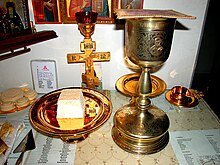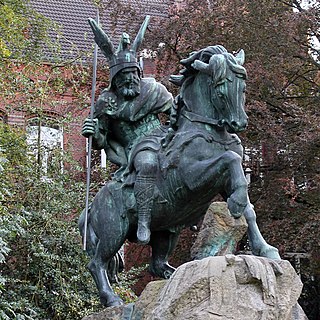
Widukind, also known as Wittekind and Wittikund, was a leader of the Saxons and the chief opponent of the Frankish king Charlemagne during the Saxon Wars from 777 to 785. Charlemagne ultimately prevailed, organized Saxony as a Frankish province, massacred thousands of Saxon nobles, and ordered conversions of the pagan Saxons to Christianity. In later times, Widukind became a symbol of Saxon independence and a figure of legend. He is also venerated as a blessed in the Catholic Church.
Crypto-Calvinism is a pejorative term describing a segment of those members of the Lutheran Church in Germany who were accused of secretly subscribing to Calvinist doctrine of the Eucharist in the decades immediately after the death of Martin Luther in 1546. It denotes what was seen as a hidden Calvinist belief, i.e., the doctrines of John Calvin, by members of the Lutheran Church. The term crypto-Calvinist in Lutheranism was preceded by terms Zwinglian and Sacramentarian. Also, Jansenism has been accused of crypto-Calvinism by Roman Catholics.

A sacristy, also known as a vestry or preparation room, is a room in Christian churches for the keeping of vestments and other church furnishings, sacred vessels, and parish records.
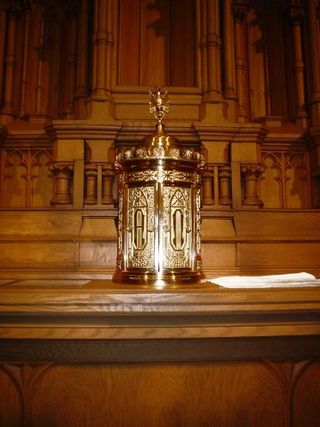
A tabernacle or a sacrament house is a fixed, locked box in which the Eucharist is stored as part of the "reserved sacrament" rite. A container for the same purpose, which is set directly into a wall, is called an aumbry.

A paten or diskos is a small plate, used during the Mass. It is generally used during the liturgy itself, while the reserved sacrament are stored in the tabernacle in a ciborium.

An ambry is a recessed cabinet in the wall of a Christian church for storing sacred vessels and vestments. They are sometimes near the piscina, but more often on the opposite side. The word also seems in medieval times to have been commonly used for any closed cupboard or even a bookcase.

The Great Saint Martin Church is a Romanesque Catholic church in Cologne, Germany. Its foundations rest on remnants of a Roman chapel, built on what was then an island in the Rhine. The church was later transformed into a Benedictine monastery. The current buildings, including a soaring crossing tower that is a landmark of Cologne's Old Town, were erected between 1150-1250. The architecture of its eastern end forms a triconch or trefoil plan, consisting of three apses around the crossing, similar to that at St. Maria im Kapitol. The church was badly damaged in World War II; restoration work was completed in 1985.

The Parish Church of Urtijëi located in the town of Urtijëi in Val Gardena in South Tyrol, Italy is dedicated to the Epiphany and to Saint Ulrich.
Martin Weber was a German architect who designed Catholic churches.

Conrad Wilhelm Hase was a German architect and Professor. He was a prominent representative of the Neo-Gothic style and is known for his preservation work.
The twelve Romanesque churches of Cologne are twelve landmark churches in the Old town (Altstadt) of Cologne, Germany. All twelve churches are Catholic.

St. Georg's Church is one of twelve Romanesque churches in the city of Cologne, Germany.

St. Maria Lyskirchen is one of twelve Romanesque churches in Cologne, Germany.
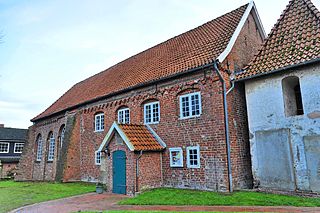
The Holy Cross Church is the church of the Neuenwalde Convent. Convent and Holy Cross Church are owned by the Bremian Knighthood, based in Stade. However, church and parsonage, are used per usufruct by the Lutheran Neuenwalde Congregation in Neuenwalde, a locality of Geestland, Lower Saxony, Germany. Besides the Holy Cross Church, only used, the congregation uses and owns the chapel in Hymendorf.
Tüchersfeld is a church village in the Püttlach valley in Franconian Switzerland and belongs to the town of Pottenstein.

Aegidien Church, after Saint Giles to whom the church was dedicated, is a war memorial in Hanover, the capital of Lower Saxony, Germany. The church dates from 1347, when it replaced an older Romanesque church dating to 1163. This in turn replaced an even earlier chapel. Aegidien Church was destroyed during the night beginning 8 October 1943 by aerial bombings of Hanover during World War II. In 1952, Aegidien Church became a war memorial dedicated to victims of war and of violence.

The Church of the Holy Cross is a Lutheran church in the centre of Hanover, the capital of Lower Saxony, Germany. A Gothic hall church, it is one of three churches in Hanover's old town – the other two being Market Church and Aegidien Church, although the latter is now a war memorial.

Kirchenlied is a German Catholic hymnal published in 1938. It was a collection of 140 old and new songs, including hymns by Protestant authors. It was the seed for a common Catholic hymnal which was realised decades later, in the Gotteslob (1975).
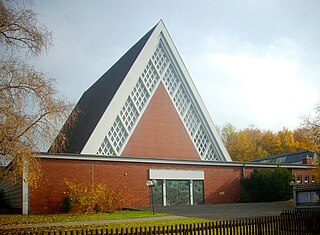
Zu den heiligen Engeln is a Catholic parish and church in Hanover-Kirchrode, Lower Saxony, Germany. The church was built in 1964 on a design by Josef Bieling, and was remodeled in 2014. It is now the parish church of a larger parish, serving the district Kirchrode-Bemerode-Wülferode. It belongs to the deanery of Hanover and the Diocese of Hildesheim. The church is dedicated to the angels.

St. Bernward is a Catholic church and parish in Döhren, part of Hanover, the capital of Lower Saxony, Germany. It was consecrated in 1893 to Bernward of Hildesheim, when part of Christoph Hehl's design of a basilica in Romanesque revival style were built, but was completed after World War II. Major artwork was added for the centenary in 1993. It became the centre of a larger parish in 2010.
